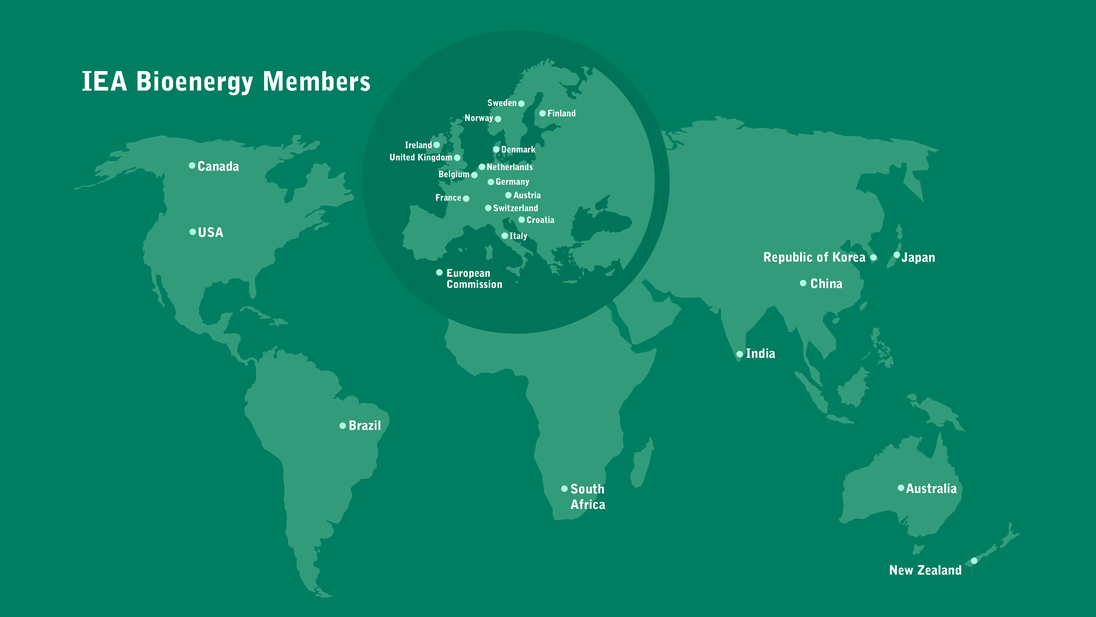What is IEA Bioenergy?
Response to a need
IEA Bioenergy is a Technology Collaboration Programme (TCP) set up in 1978 by the International Energy Agency (IEA) with the aim of improving cooperation and information exchange between countries that have national programmes in bioenergy research, development and deployment. Technology Collaboration Programmes are independent bodies operating in a framework provided by the IEA. There are 39 currently active Technology Collaboration Programmes, one of which is IEA Bioenergy.
IEA Bioenergy’s vision is that modern bioenergy is, and will continue to be, a leading type of renewable energy, making an important contribution in reaching an energy secure and net-zero energy mix. Bioenergy is an integral part of developments towards a circular biobased economy. By accelerating the sustainable production and efficient use of biomass, economic and environmental impacts will be optimised resulting in more cost-competitive bioenergy and biobased applications and reduced greenhouse gas emissions.
The mission of IEA Bioenergy is to increase knowledge and understanding of bioenergy systems in order to facilitate the commercialisation and market deployment of environmentally sound, socially acceptable, and cost-competitive, low-carbon bioenergy systems and technologies, and to advise policy and industrial decision makers accordingly. IEA Bioenergy realises the mission by providing platforms for international collaboration and information exchange in bioenergy research, technology development, demonstration, and policy analysis—including through network development, information dissemination, and the provision of science-based analysis and advice.
Working together gets results
Progress in energy technology is critical to achieving the objectives of energy security, environmental protection and economic and social development. International collaboration is needed to prepare practical responses to global environmental issues. Energy technology innovation is occurring in an inter-connected world in which national efforts to adapt to change no longer suffice. National energy RD&D and deployment programmes gain impact when incorporated into the larger context of international interdependence.
IEA Bioenergy offers opportunities to coordinate the work of national programmes across the wide range of bioenergy technologies.
How to join IEA Bioenergy
Contracting parties to the IEA Bioenergy TCP are usually governments. Therefore, you need to seek support from your government to join IEA Bioenergy. The government will later appoint a member and an alternate to represent the Contracting Party (CP) in the Executive Committee (ExCo).
Alternatively, it may be possible to join as a sponsor, without the need for the government of your country to join. Special terms and conditions apply for sponsors.
Each CP pays a fixed annual contribution of US$6,700 to the central administration of the ExCo. In addition, each CP chooses the Tasks it will join (at least one). The institution participating in a Task does not necessarily need to be the institution of the ExCo member. The annual cost for each Task ranges from US$15,000 to US$18,500.
If you are interested in joining IEA Bioenergy, you may contact the Secretary at secretary@ieabioenergy.com
Benefits of IEA Bioenergy
IEA Bioenergy provides an umbrella organisation and structure for a collective effort where national experts from research, government and industry work together with experts from other member countries. Resources are provided in two main ways:
- Cost Sharing – participants contribute to a common fund for conducting research projects and information exchange.
- Task Sharing – participants devote specified resources and personnel to conduct an agreed work programme.
The collaboration offers many benefits at both the policy and technical level including the ability to:
- Strengthen national R&D capabilities.
- Share research costs.
- Pool technical resources.
- Avoid duplication and unproductive research paths.
- Network researchers.
- Standardise methodologies.
- Harmonise technical standards.
- Enhance the quality of R&D outputs.
- Disseminate information on technology capabilities.
- Accelerate the deployment of new technologies.
- Build a common understanding of the technical basis for issues.
- Investigate barriers to implementation.
- Contribute to energy policy development.
Researchers, policy-makers and industry can all capitalise on these benefits.
Collaborative opportunities
IEA Bioenergy provides opportunities for:
- Researchers – to exchange information on recent developments in R&D through networking, meetings and/or workshops; to provide opportunities for collaborative R&D.
- Industry – to be informed of new projects; to work together to develop handbooks or models; to offer early participation of industrial partners in RD&D work.
- Policy-makers and decision-makers – to gain an international perspective on progress in bioenergy; to compile guidelines and standards; to gain new perspectives on deployment opportunities and issues.
IEA Bioenergy Members
Twenty four countries plus the European Commission participate in IEA Bioenergy.



